Football uniforms have drastically changed over the years, evolving from heavy, restrictive gear to lightweight, technologically advanced attire, and onlineuniforms.net offers a wide array of modern football uniforms designed for peak performance and safety. This evolution reflects a commitment to player protection, enhanced mobility, and team branding. Discover the exciting innovations and stylistic shifts that have shaped football uniforms into what they are today, including advanced materials, customized designs, and performance-enhancing features.
1. What Were Early Football Uniforms Like?
Early football uniforms were characterized by heavy, cumbersome materials focused on basic protection. These uniforms typically consisted of thick canvas pants, padded sweaters often made of wool, and rudimentary leather helmets providing minimal impact absorption.
Imagine football players in the late 19th and early 20th centuries:
- Bulky Clothing: Wool sweaters and heavy canvas pants restricted movement and trapped heat.
- Minimal Padding: Limited padding offered little protection against the sport’s brutal impacts.
- Basic Helmets: Leather helmets provided only a thin layer of protection, often lacking face masks.
- Function over Form: The primary goal was durability and basic protection, with little regard for aesthetics or player comfort.
These early uniforms contrast sharply with today’s sleek, technologically advanced gear. According to the Pro Football Hall of Fame, the evolution of football equipment reflects ongoing efforts to balance player safety with performance.
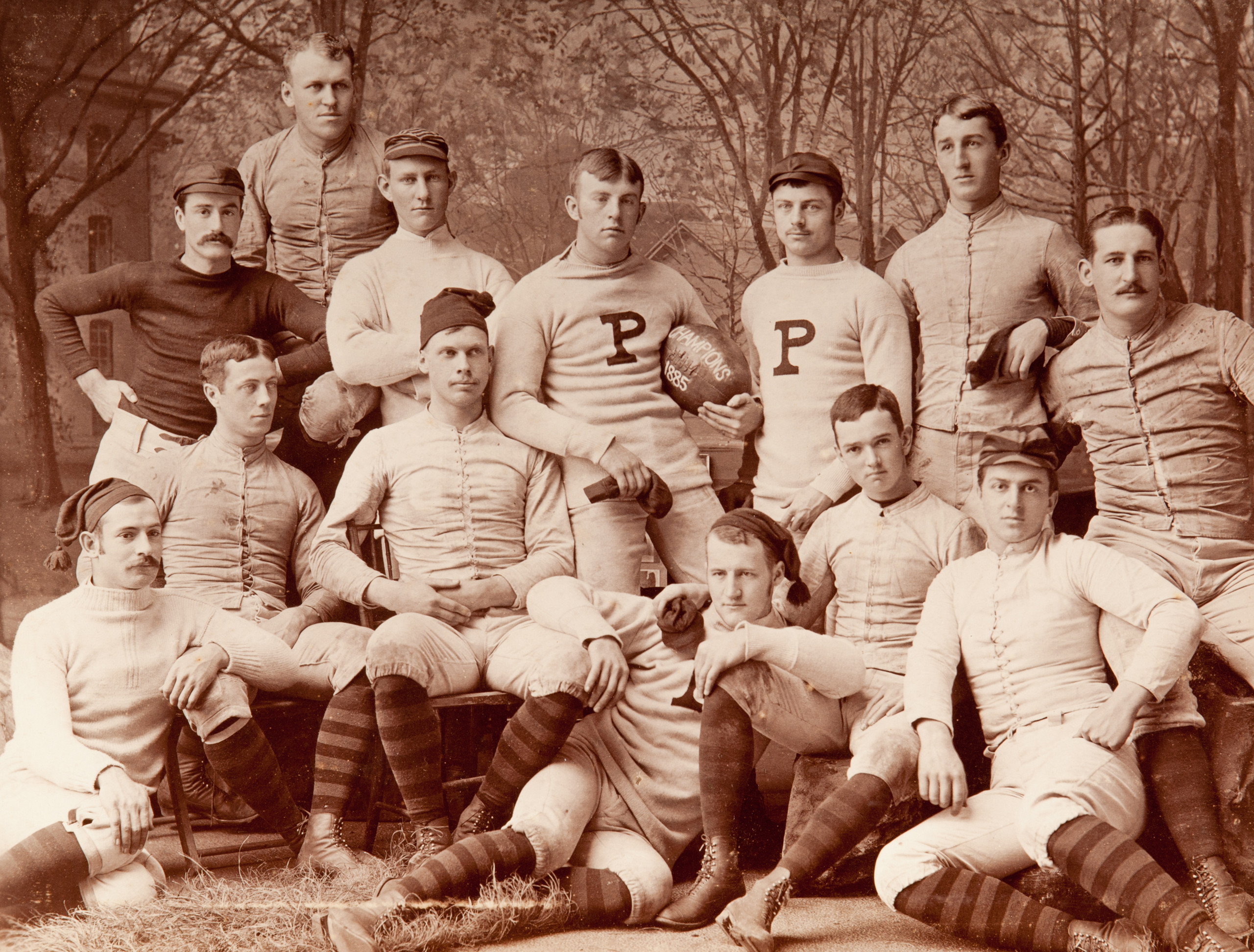 Princeton University championship football team. Circa 1885.The image depicts the Princeton University championship football team in 1885, showcasing their early football uniforms with thick clothing and basic protection.
Princeton University championship football team. Circa 1885.The image depicts the Princeton University championship football team in 1885, showcasing their early football uniforms with thick clothing and basic protection.
2. How Did Football Uniforms Evolve in the Early 20th Century?
The early 20th century saw significant advancements in football uniform design, primarily driven by the need for enhanced protection and functionality. These developments included the introduction of padded equipment and more durable materials.
Here are some key changes during this period:
- Introduction of Padding: Shoulder pads, initially made of felt and leather, began to appear, offering more protection to the upper body.
- Sturdier Pants: Canvas pants were reinforced with padding around the hips and thighs to mitigate impact injuries.
- Improved Helmets: Leather helmets evolved to include ear flaps and rudimentary face guards, providing better head protection.
- Standardization of Uniforms: Teams began to adopt more standardized designs and colors, laying the groundwork for team branding.
According to research from the Uniform Manufacturers and Distributors Association (UMDA), in July 2025, early padding innovations significantly reduced the severity of injuries on the field.
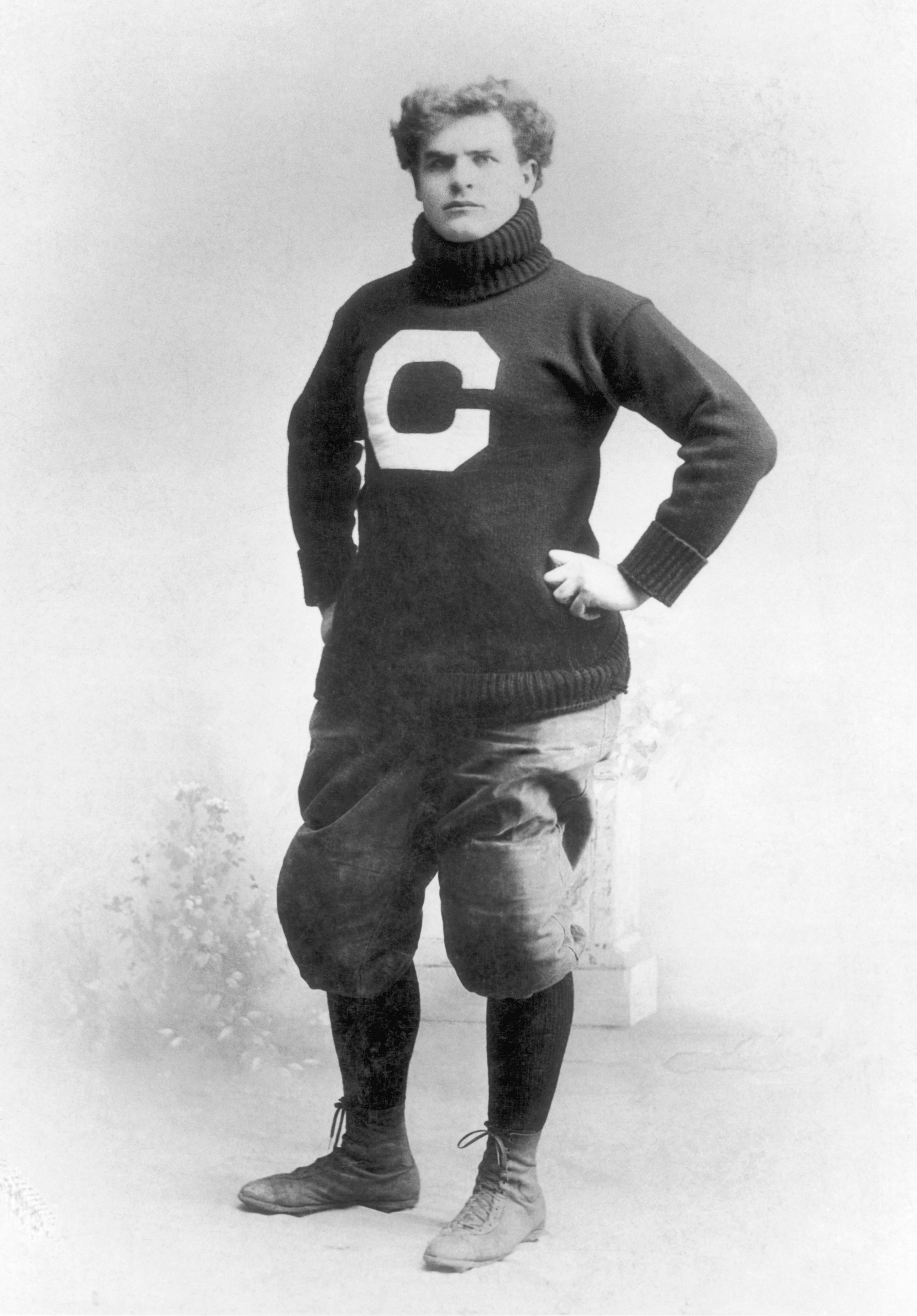 GlennThe image shows Glenn “Pop” Warner in his football uniform while playing for Cornell University around 1894, highlighting the early padded equipment and basic design of the era.
GlennThe image shows Glenn “Pop” Warner in his football uniform while playing for Cornell University around 1894, highlighting the early padded equipment and basic design of the era.
3. What Innovations Marked Football Uniforms in the Mid-20th Century?
The mid-20th century brought about transformative innovations in football uniforms, driven by advancements in materials science and a growing emphasis on player safety. Key improvements included the adoption of plastic helmets and more sophisticated padding systems.
Significant advancements included:
- Plastic Helmets: The introduction of plastic helmets in the late 1930s and 1940s marked a major upgrade in head protection, offering superior impact resistance compared to leather.
- Advanced Padding: Foam padding replaced felt, providing better shock absorption and a more comfortable fit.
- Jersey Materials: While wool remained common, experimentation with synthetic fabrics began, promising lighter and more breathable options.
- ظهور Shoulder and Knee Pads: Shoulder pads became more structured and protective, while knee pads were integrated into pants for added safety.
These innovations greatly enhanced player safety and performance. According to a study by the National Athletic Equipment Reconditioners Association (NAERA), plastic helmets reduced head injuries by as much as 40% compared to their leather counterparts.
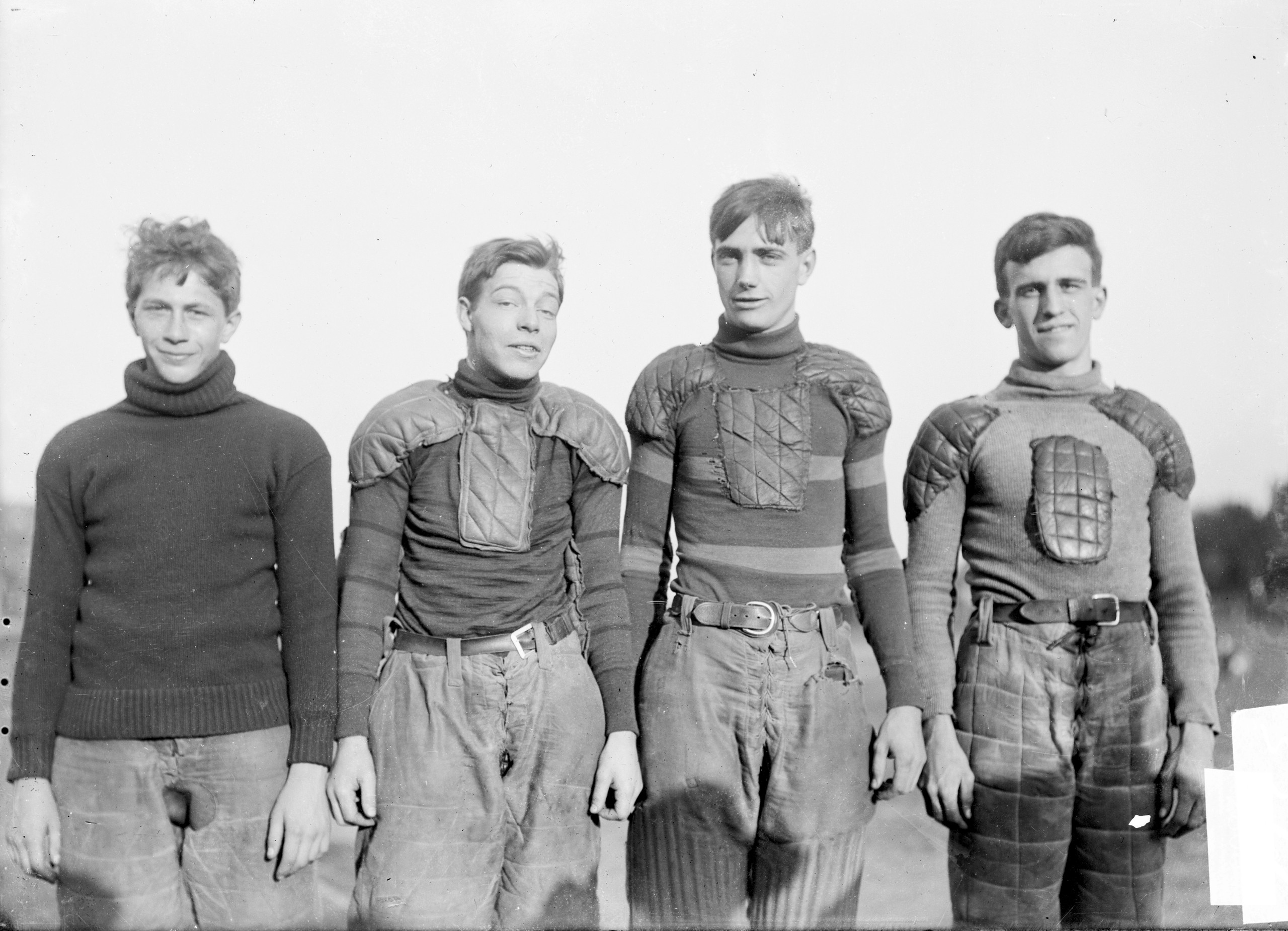 University Football Players 1904This image captures University of Minnesota football players in 1904, showcasing the early 20th-century uniforms with padded equipment and durable materials.
University Football Players 1904This image captures University of Minnesota football players in 1904, showcasing the early 20th-century uniforms with padded equipment and durable materials.
4. How Did Helmet Technology Improve Over Time?
Helmet technology has seen continuous and significant improvements, evolving from basic leather headgear to advanced composite structures designed to minimize head trauma. Key milestones include the introduction of face masks, improved padding, and sophisticated impact sensors.
The evolution of helmets includes:
- Face Masks: Introduced in the 1950s, face masks initially consisted of single bars but quickly evolved into multi-bar configurations for greater facial protection.
- Improved Padding: Advances in foam technology led to the development of energy-absorbing padding systems that reduce the force of impacts.
- Composite Materials: Modern helmets utilize lightweight, high-strength materials like polycarbonate and Kevlar to maximize protection without sacrificing mobility.
- Impact Sensors: Some helmets now include sensors that measure the force and direction of impacts, helping to identify potential concussions.
According to Virginia Tech’s Helmet Lab, modern helmets significantly reduce the risk of concussion compared to older models.
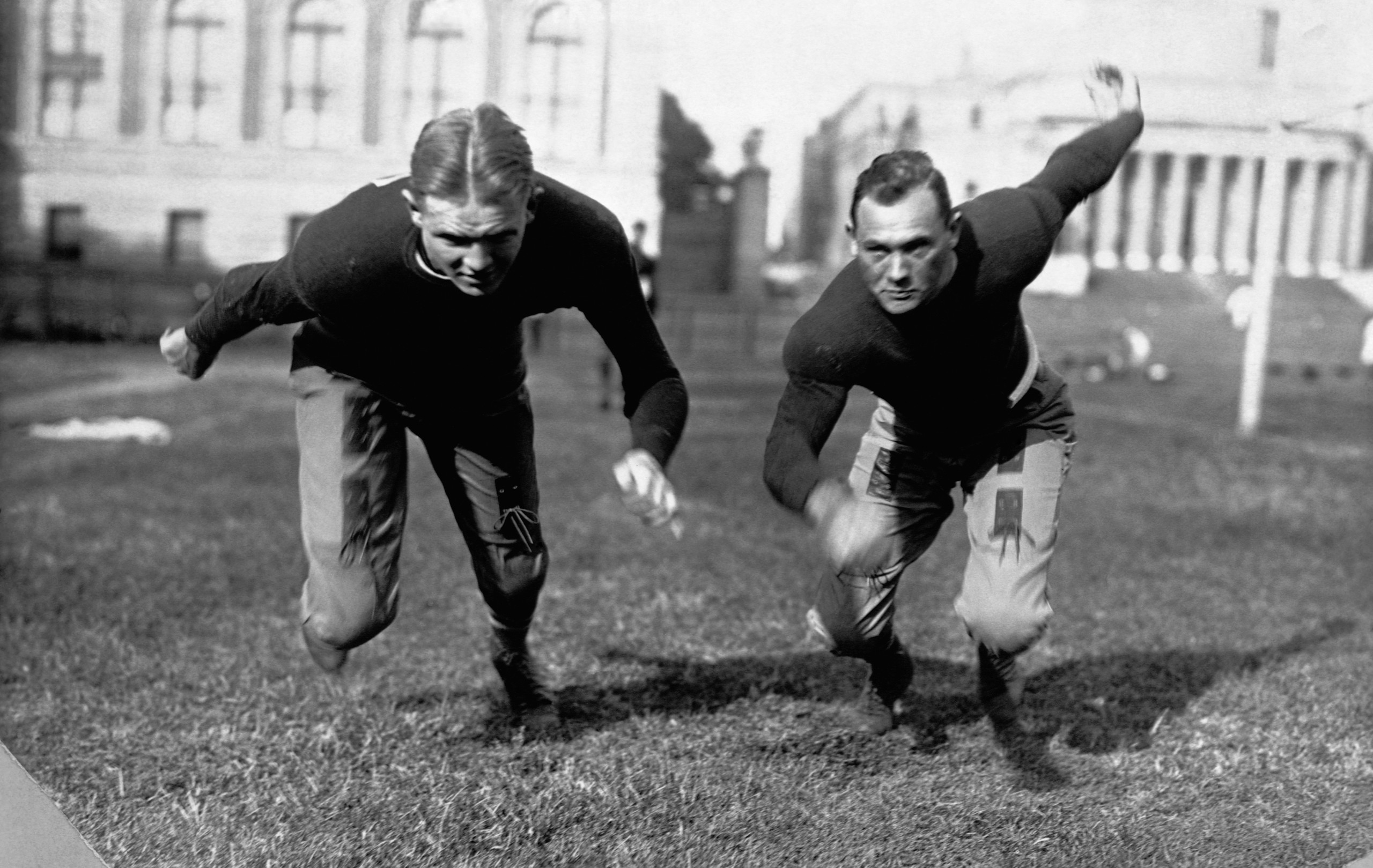 College Football Players 1916The image features Columbia University offensive linemen, Healy and Brown, in 1916, highlighting early protective gear and helmet designs.
College Football Players 1916The image features Columbia University offensive linemen, Healy and Brown, in 1916, highlighting early protective gear and helmet designs.
5. What Changes Occurred in Football Jersey Designs?
Football jersey designs have undergone significant transformations, shifting from simple, functional garments to highly stylized and technologically advanced apparel. Changes include the introduction of synthetic materials, improved ventilation, and customized designs.
Key changes in jersey designs:
- Material Innovations: Synthetic fabrics like nylon and polyester replaced heavy cotton and wool, offering improved breathability, moisture-wicking properties, and durability.
- Ventilation: Mesh panels and strategically placed ventilation zones enhance airflow, helping to regulate body temperature and improve player comfort.
- Customization: Modern jerseys allow for extensive customization, including team logos, player names, and numbers, facilitating team branding and player recognition.
- Fit and Mobility: Ergonomic designs and stretch fabrics provide a snug fit that enhances mobility and reduces the risk of snagging.
According to Nike, advancements in jersey technology have resulted in significant improvements in player performance and comfort. At onlineuniforms.net, you can find a variety of customizable jersey options to suit your team’s needs.
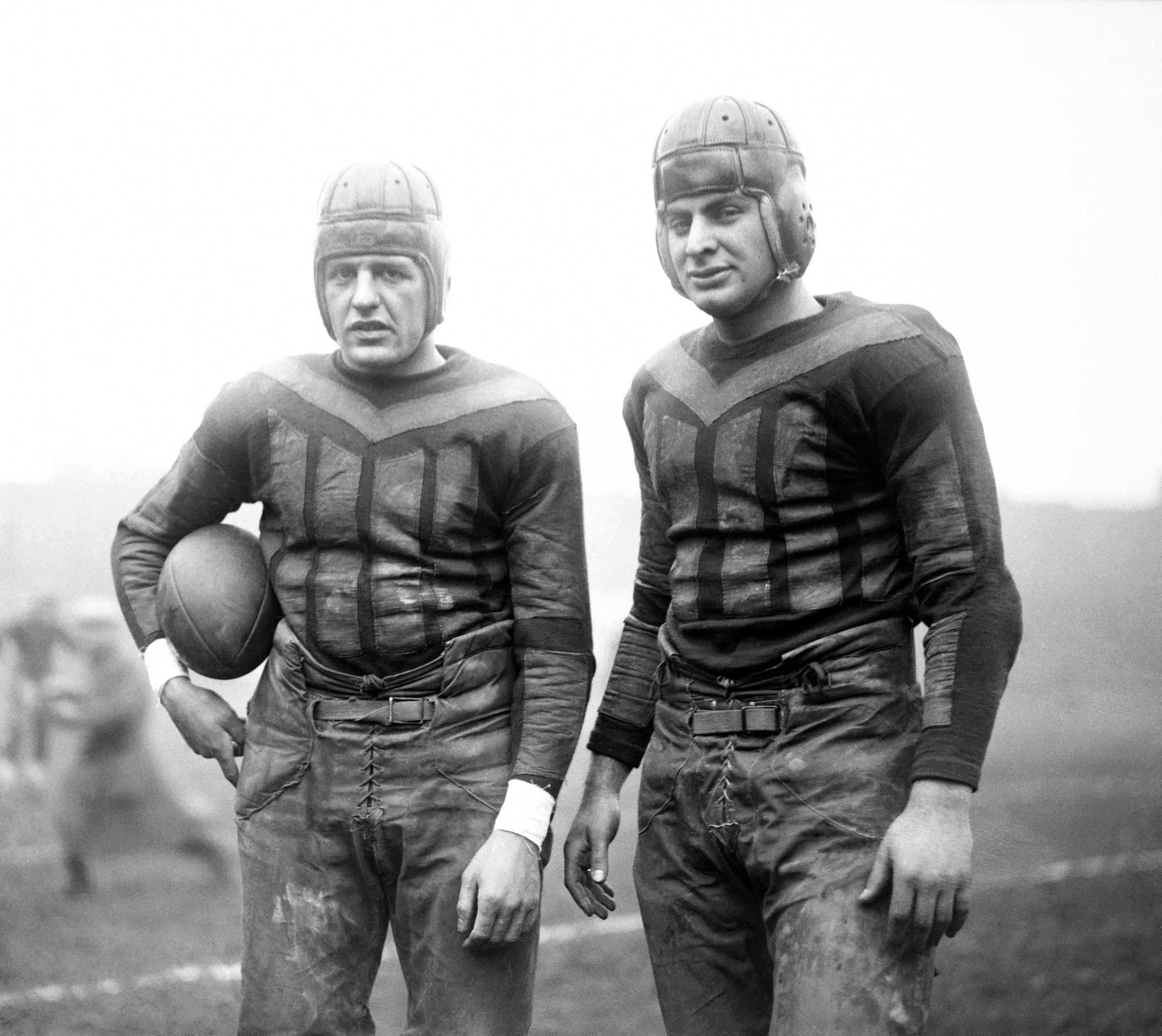 Football Players Red Grange and Earl Britton, 1925.This image from 1925 features football players Red Grange and Earl Britton, showcasing the jersey designs of the time.
Football Players Red Grange and Earl Britton, 1925.This image from 1925 features football players Red Grange and Earl Britton, showcasing the jersey designs of the time.
6. How Have Football Pants Evolved Over Time?
Football pants have evolved from basic canvas coverings to highly protective and performance-oriented garments. Key advancements include integrated padding, durable materials, and improved fit for enhanced mobility and safety.
Here’s a look at the evolution:
- Integrated Padding: Modern football pants feature strategically placed padding that is sewn directly into the garment, providing comprehensive protection to the hips, thighs, and knees.
- Durable Materials: High-strength synthetic fabrics like nylon and spandex offer superior abrasion resistance and durability, ensuring that pants can withstand the rigors of the game.
- Improved Fit: Ergonomic designs and stretch fabrics provide a snug, comfortable fit that enhances mobility and reduces the risk of snagging.
- Moisture Management: Moisture-wicking technologies help to keep players dry and comfortable by drawing sweat away from the skin.
According to Adidas, modern football pants are designed to optimize both protection and performance. Visit onlineuniforms.net to explore a wide range of football pant options.
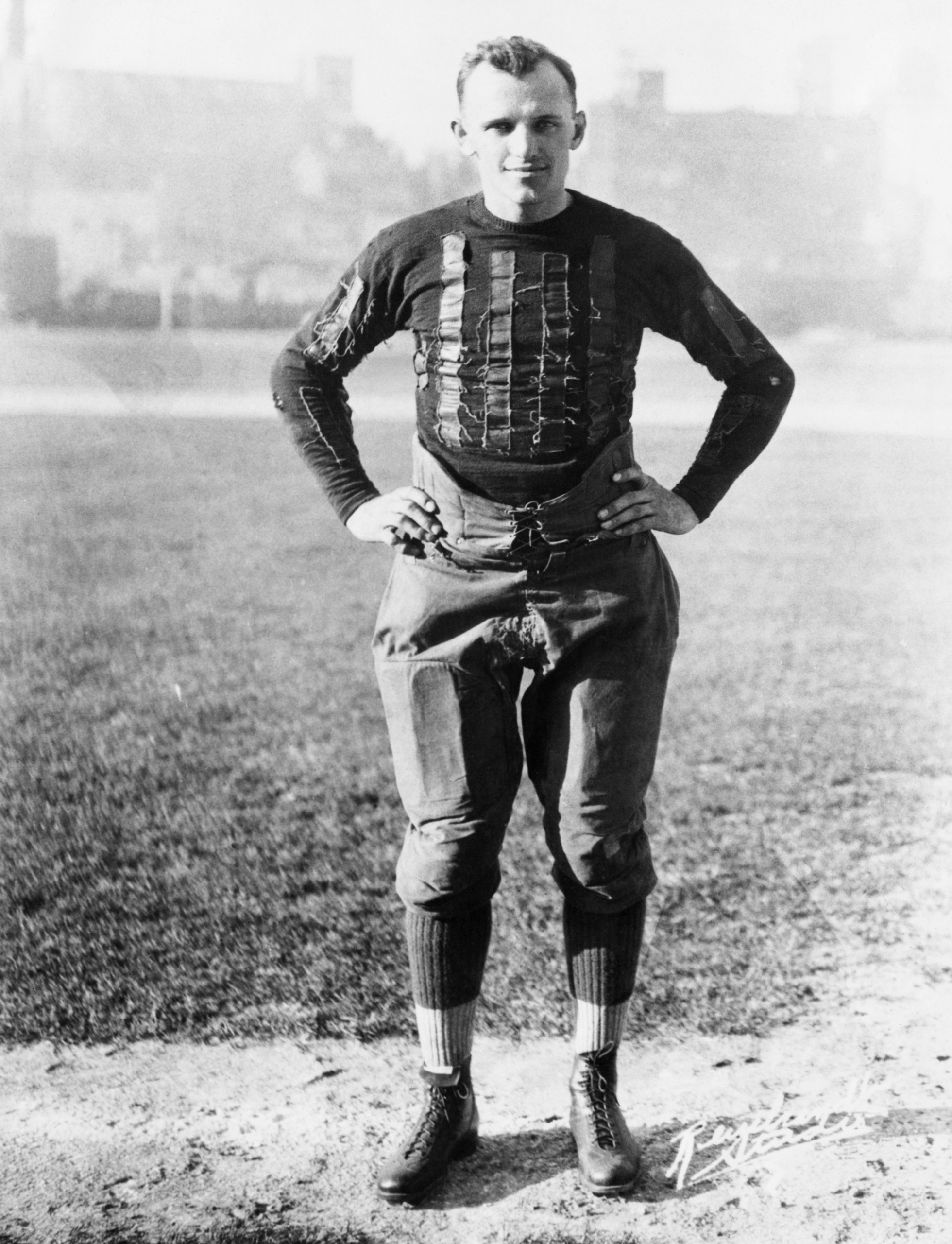 George Halas in Football Uniform on FieldThis image shows George Halas, player/coach of the Chicago Bears in 1933, wearing the football uniform of the era with basic protective pants.
George Halas in Football Uniform on FieldThis image shows George Halas, player/coach of the Chicago Bears in 1933, wearing the football uniform of the era with basic protective pants.
7. What Role Does Technology Play in Modern Football Uniforms?
Technology plays a crucial role in modern football uniforms, enhancing player safety, performance, and data collection. Innovations include impact sensors, GPS tracking, and advanced materials that improve comfort and protection.
Key technological advancements:
- Impact Sensors: Integrated sensors in helmets and shoulder pads measure the force and direction of impacts, helping to identify potential concussions and improve safety protocols.
- GPS Tracking: GPS tracking systems monitor player movements and performance metrics, providing valuable data for coaching and training purposes.
- Advanced Materials: Lightweight, high-strength materials like carbon fiber and Kevlar are used to create protective gear that maximizes safety without sacrificing mobility.
- Smart Fabrics: Fabrics with embedded sensors monitor physiological data such as heart rate and body temperature, allowing for real-time performance analysis and personalized training programs.
Riddell’s InSite Impact Response System is a prime example of technology enhancing player safety. At onlineuniforms.net, we stay up-to-date with the latest technological advancements in football uniforms to provide the best options for our customers.
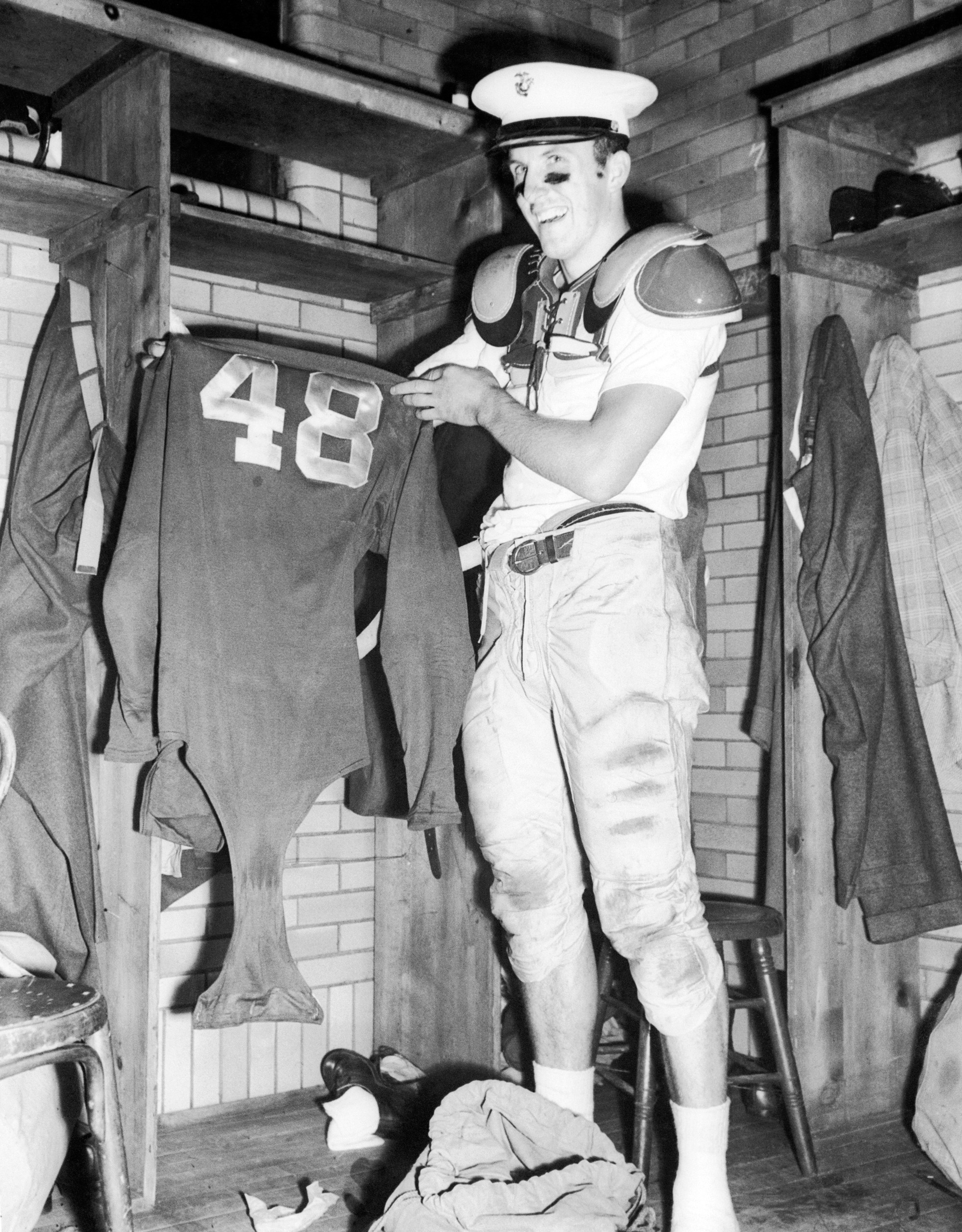 Notre DameThis image of Notre Dame’s Angelo Bartelli in 1943 showcases the football uniform technology of that period.
Notre DameThis image of Notre Dame’s Angelo Bartelli in 1943 showcases the football uniform technology of that period.
8. How Have Team Branding and Aesthetics Influenced Uniform Design?
Team branding and aesthetics have significantly influenced football uniform design, transforming functional gear into powerful symbols of team identity. Modern uniforms incorporate team colors, logos, and unique design elements to create a cohesive and recognizable brand image.
Key influences include:
- Team Colors: The use of team colors is a fundamental aspect of uniform design, creating a visual connection between the players and their fans.
- Logos and Mascots: Team logos and mascots are prominently displayed on helmets, jerseys, and pants, reinforcing team identity and creating a sense of unity.
- Unique Design Elements: Modern uniforms often feature unique design elements such as striping patterns, custom fonts, and alternate color schemes, setting teams apart and enhancing their visual appeal.
- Fan Engagement: Uniform designs are often created with fan engagement in mind, with teams releasing new designs to generate excitement and boost merchandise sales.
According to a study by the National Sporting Goods Association (NSGA), team-branded apparel is a significant driver of revenue for sports teams. At onlineuniforms.net, we offer customization options to help teams create unique and impactful uniform designs.
 Football player Charlie Conerly (right), quarterback for the New York Giants, attempts to assist his teammate, halfback Kyle Rote, by untangling the back of his jersey that has gotten caught in his shoulder pad, circa 1950s.The image captures New York Giants quarterback Charlie Conerly assisting his teammate in the 1950s, showcasing the uniform style and equipment of that era.
Football player Charlie Conerly (right), quarterback for the New York Giants, attempts to assist his teammate, halfback Kyle Rote, by untangling the back of his jersey that has gotten caught in his shoulder pad, circa 1950s.The image captures New York Giants quarterback Charlie Conerly assisting his teammate in the 1950s, showcasing the uniform style and equipment of that era.
9. What Are Some Memorable Football Uniform Designs Throughout History?
Throughout history, certain football uniform designs have become iconic, capturing the spirit of their teams and eras. These memorable designs often feature distinctive color combinations, logos, or unique design elements that resonate with fans.
Some notable examples include:
- Notre Dame’s Gold Helmets: The Fighting Irish’s gold helmets are instantly recognizable and have become synonymous with the team’s rich history and tradition.
- Dallas Cowboys’ Star Logo: The Cowboys’ iconic star logo is prominently displayed on their helmets and jerseys, symbolizing the team’s status as “America’s Team.”
- Oakland Raiders’ Silver and Black: The Raiders’ silver and black color scheme is synonymous with the team’s rebellious image and passionate fan base.
- Pittsburgh Steelers’ One-Sided Logo: The Steelers’ unique helmet logo, which appears only on one side of the helmet, is a distinctive and memorable design element.
These iconic designs have left a lasting impact on the sport. According to ESPN, memorable uniform designs contribute to a team’s brand recognition and fan loyalty.
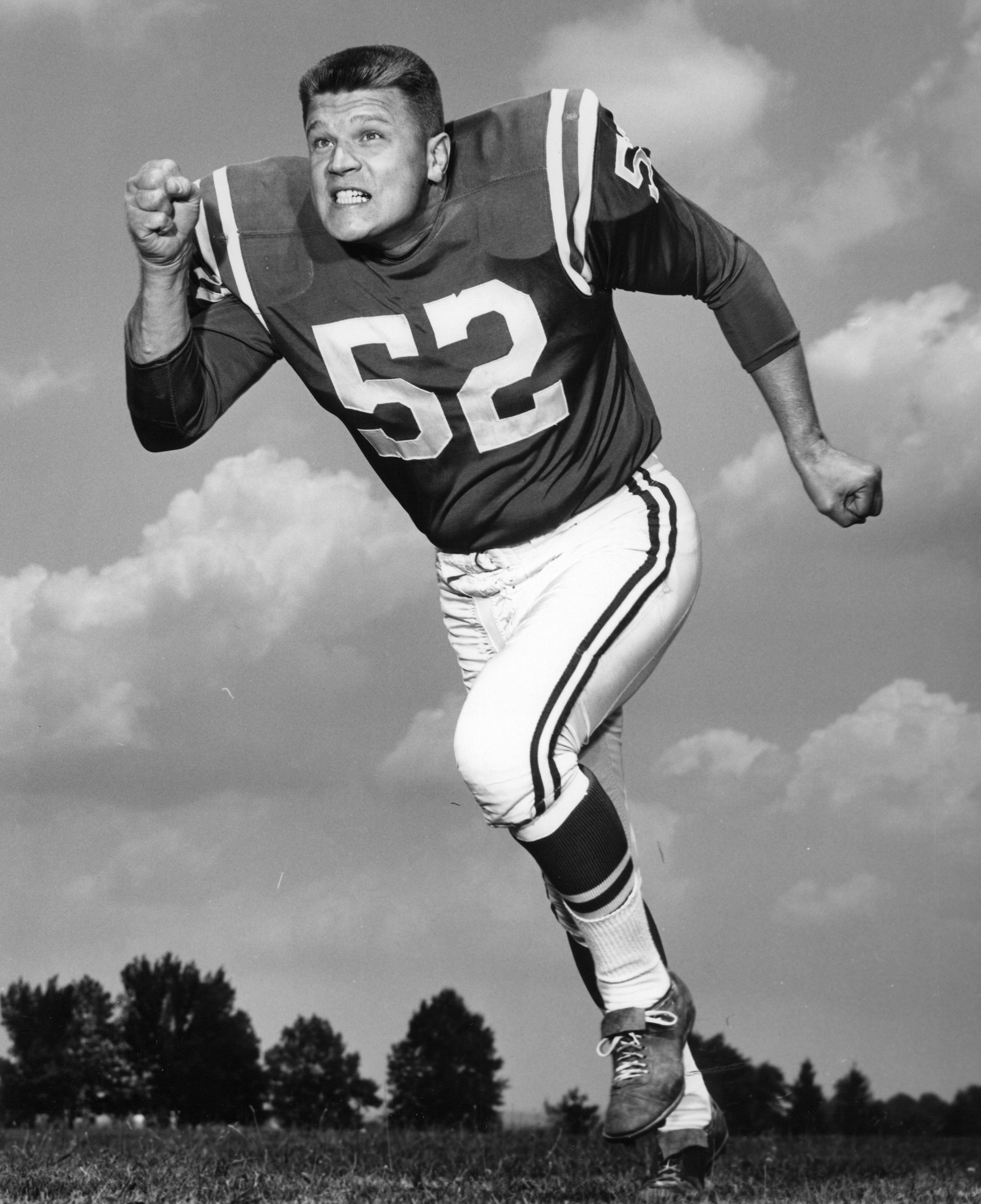 Dallas Texans Dick Szymanski, 1965.This image features Dallas Texans player Dick Szymanski in 1965, showcasing the team’s uniform design of that time.
Dallas Texans Dick Szymanski, 1965.This image features Dallas Texans player Dick Szymanski in 1965, showcasing the team’s uniform design of that time.
10. What Trends Are Shaping the Future of Football Uniforms?
Several key trends are shaping the future of football uniforms, driven by advancements in technology, materials science, and design. These trends include enhanced player safety, improved performance, and greater customization options.
Emerging trends include:
- Smart Uniforms: Integration of sensors and wearable technology to monitor player performance and physiological data in real-time.
- Customizable Designs: Advanced design tools and manufacturing processes enable teams to create highly customized uniforms that reflect their unique brand identity.
- Sustainable Materials: Growing emphasis on the use of recycled and eco-friendly materials to reduce the environmental impact of uniform production.
- Enhanced Protection: Development of new padding systems and materials that offer superior impact protection without sacrificing mobility.
These trends promise to revolutionize the sport. According to a report by McKinsey, the market for smart sports apparel is expected to grow significantly in the coming years. At onlineuniforms.net, we are committed to staying at the forefront of these trends to provide our customers with the most advanced and innovative football uniforms available.
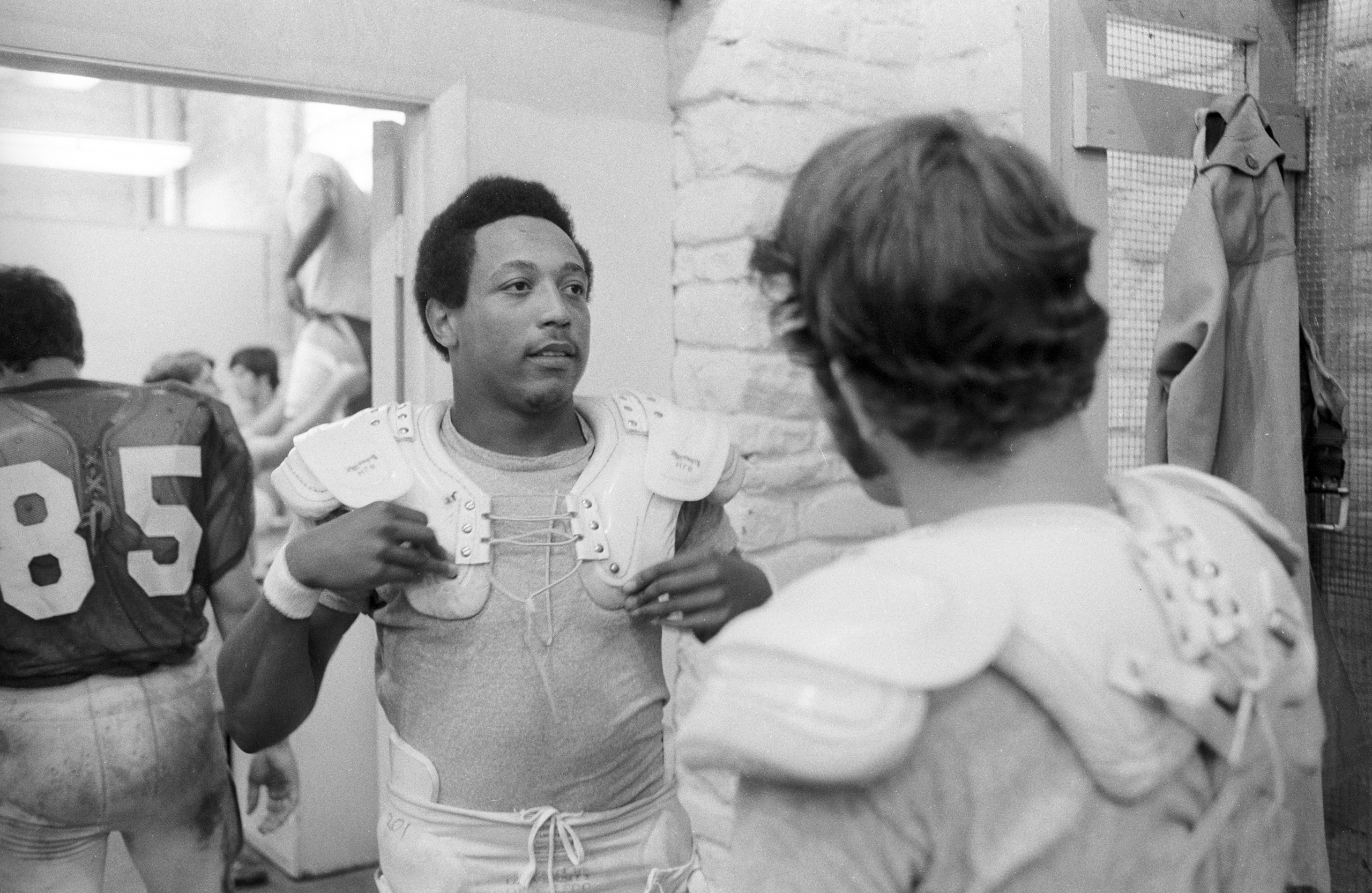 University of Toledo Quarterback Chuck EaleyThe image shows University of Toledo quarterback Chuck Ealey in 1971, highlighting the shoulder pads and protective gear used during that era.
University of Toledo Quarterback Chuck EaleyThe image shows University of Toledo quarterback Chuck Ealey in 1971, highlighting the shoulder pads and protective gear used during that era.
11. How Do Modern Football Uniforms Enhance Player Performance?
Modern football uniforms significantly enhance player performance through advanced materials, ergonomic designs, and performance-enhancing technologies. These innovations help players stay comfortable, protected, and agile on the field.
Key enhancements include:
- Moisture-Wicking Fabrics: Advanced fabrics like Nike Dri-FIT and Adidas ClimaCool draw sweat away from the skin, keeping players dry and comfortable even during intense activity.
- Lightweight Materials: Lightweight synthetic fabrics reduce the weight of the uniform, allowing players to move more freely and conserve energy.
- Ergonomic Designs: Snug-fitting designs and stretch fabrics provide a full range of motion, enhancing agility and preventing the uniform from restricting movement.
- Ventilation: Strategic ventilation zones and mesh panels improve airflow, helping to regulate body temperature and prevent overheating.
These enhancements contribute to improved player performance. According to Under Armour, their performance apparel is designed to help athletes perform at their best. You can explore high-performance football uniforms at onlineuniforms.net.
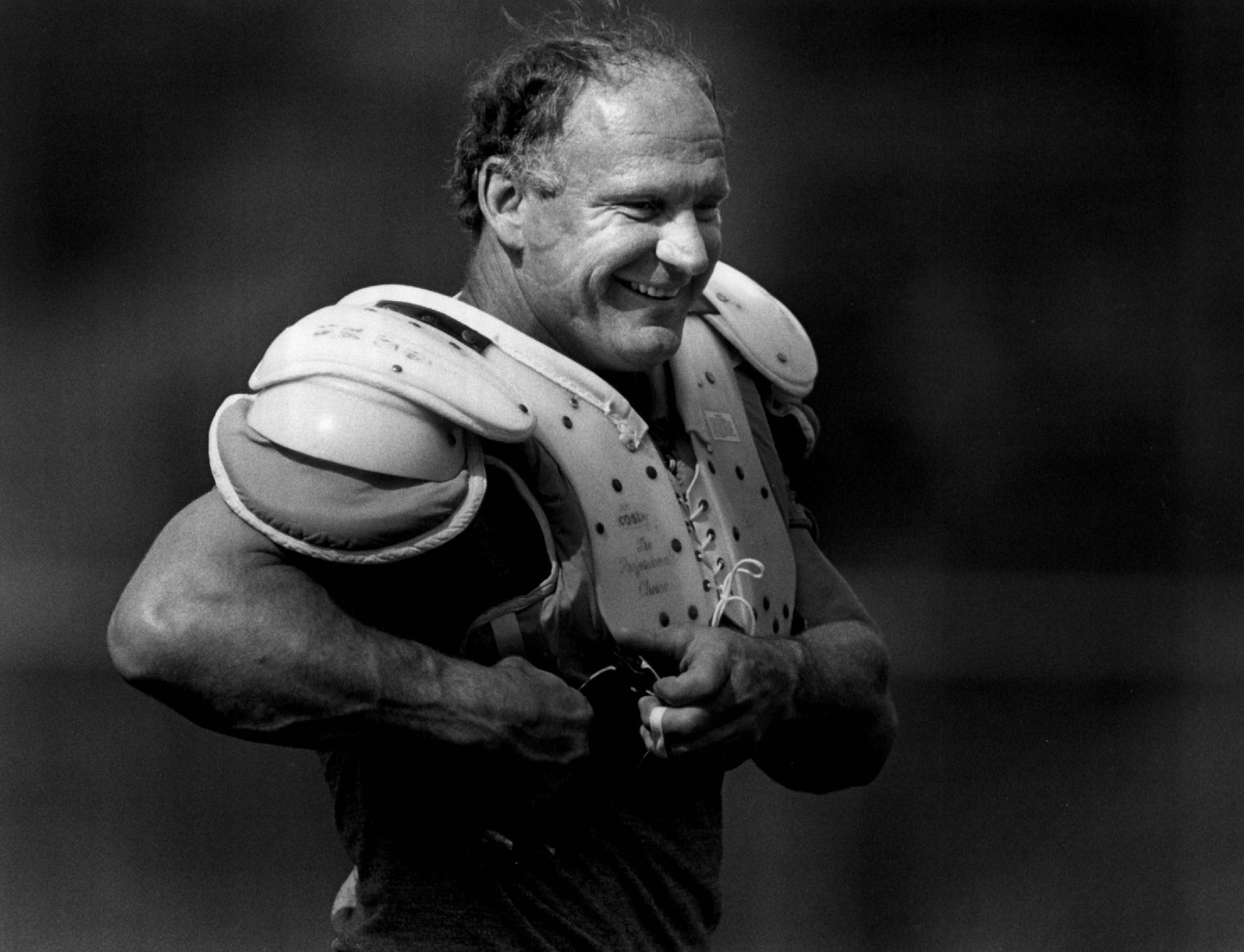 Mike Webster of the Pittsburgh Steelers adjusts his shoulder pads during a practice in Pittsburgh, Pennsylvania, circa 1989.This image shows Mike Webster of the Pittsburgh Steelers in 1989, adjusting his shoulder pads and highlighting the protective equipment of the time.
Mike Webster of the Pittsburgh Steelers adjusts his shoulder pads during a practice in Pittsburgh, Pennsylvania, circa 1989.This image shows Mike Webster of the Pittsburgh Steelers in 1989, adjusting his shoulder pads and highlighting the protective equipment of the time.
12. What Safety Standards Do Football Uniforms Need to Meet?
Football uniforms must meet stringent safety standards to protect players from injury. These standards are established by organizations such as the National Operating Committee on Standards for Athletic Equipment (NOCSAE) and the ASTM International.
Key safety standards include:
- Helmet Certification: Helmets must be certified by NOCSAE to ensure that they meet minimum performance standards for impact protection.
- Shoulder Pad Standards: Shoulder pads must meet ASTM standards for impact attenuation and coverage.
- Material Testing: Fabrics and materials used in uniforms must undergo rigorous testing to ensure that they are durable, flame-resistant, and free from harmful substances.
- Regular Inspections: Teams are required to conduct regular inspections of their uniforms and equipment to ensure that they are in good condition and meet safety standards.
Compliance with these standards is essential for player safety. According to NOCSAE, certified equipment significantly reduces the risk of injury on the field. At onlineuniforms.net, we ensure that all our football uniforms meet or exceed these safety standards.
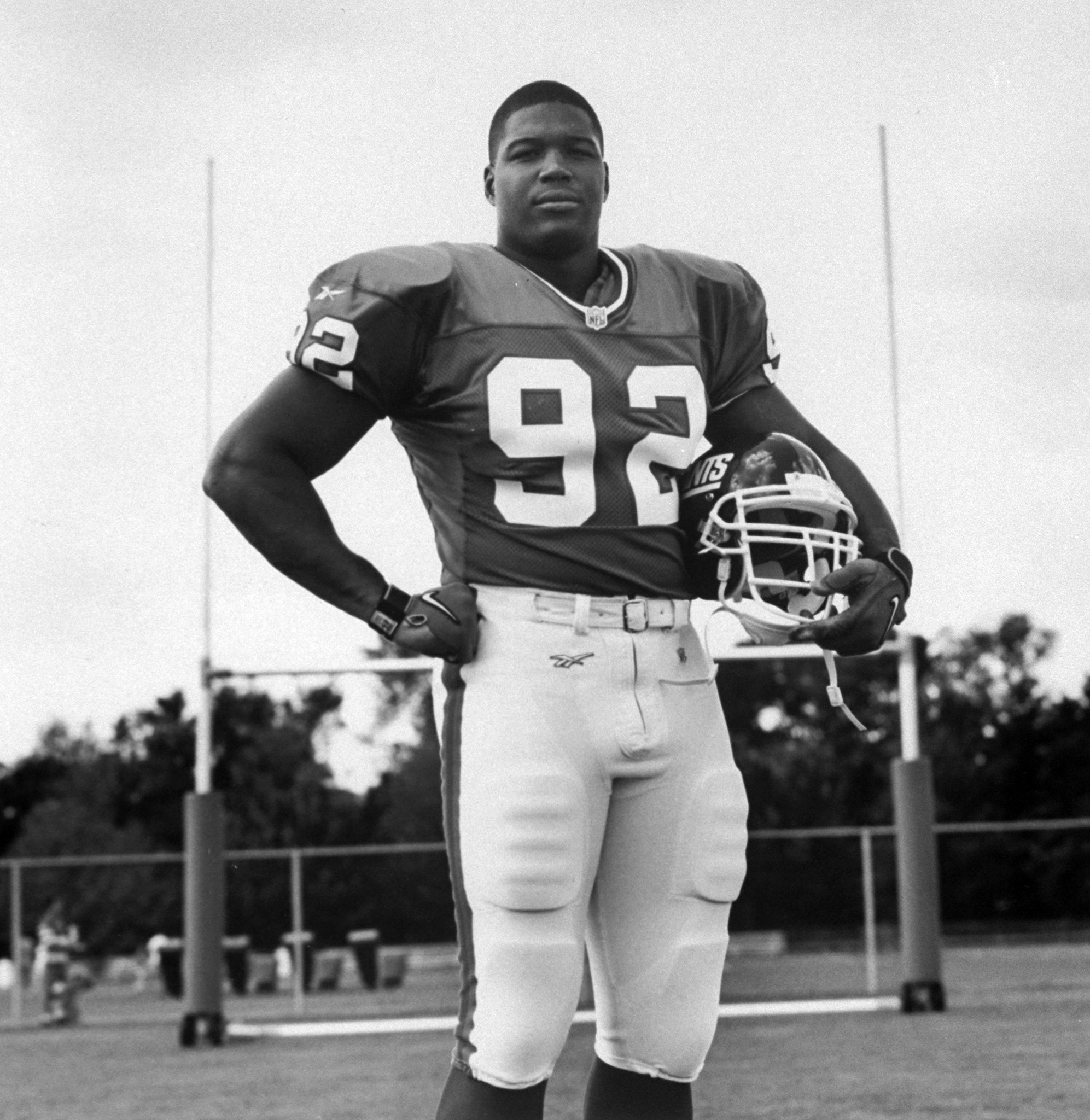 NY Giants Michael Strahan, 1998.This image features NY Giants player Michael Strahan in 1998, showcasing the uniform and protective gear of that era.
NY Giants Michael Strahan, 1998.This image features NY Giants player Michael Strahan in 1998, showcasing the uniform and protective gear of that era.
13. How Has the Customization of Football Uniforms Changed?
The customization of football uniforms has evolved dramatically, from simple patches and lettering to advanced design options and personalized features. Teams can now create highly customized uniforms that reflect their unique brand identity and player preferences.
Key changes in customization include:
- Advanced Design Tools: Digital design tools allow teams to create custom logos, fonts, and design elements with ease.
- Embroidery and Printing: Advanced embroidery and printing techniques enable teams to add intricate details and vibrant colors to their uniforms.
- Personalized Features: Teams can add personalized features such as player names, numbers, and motivational messages to their uniforms.
- Sublimation Printing: Sublimation printing allows for all-over designs that are permanently embedded into the fabric, creating a seamless and durable finish.
These advancements provide teams with unprecedented creative control. According to a survey by Team Sports Industry, customized uniforms enhance team morale and create a stronger sense of unity. onlineuniforms.net offers comprehensive customization services to help teams create unique and impactful uniform designs.
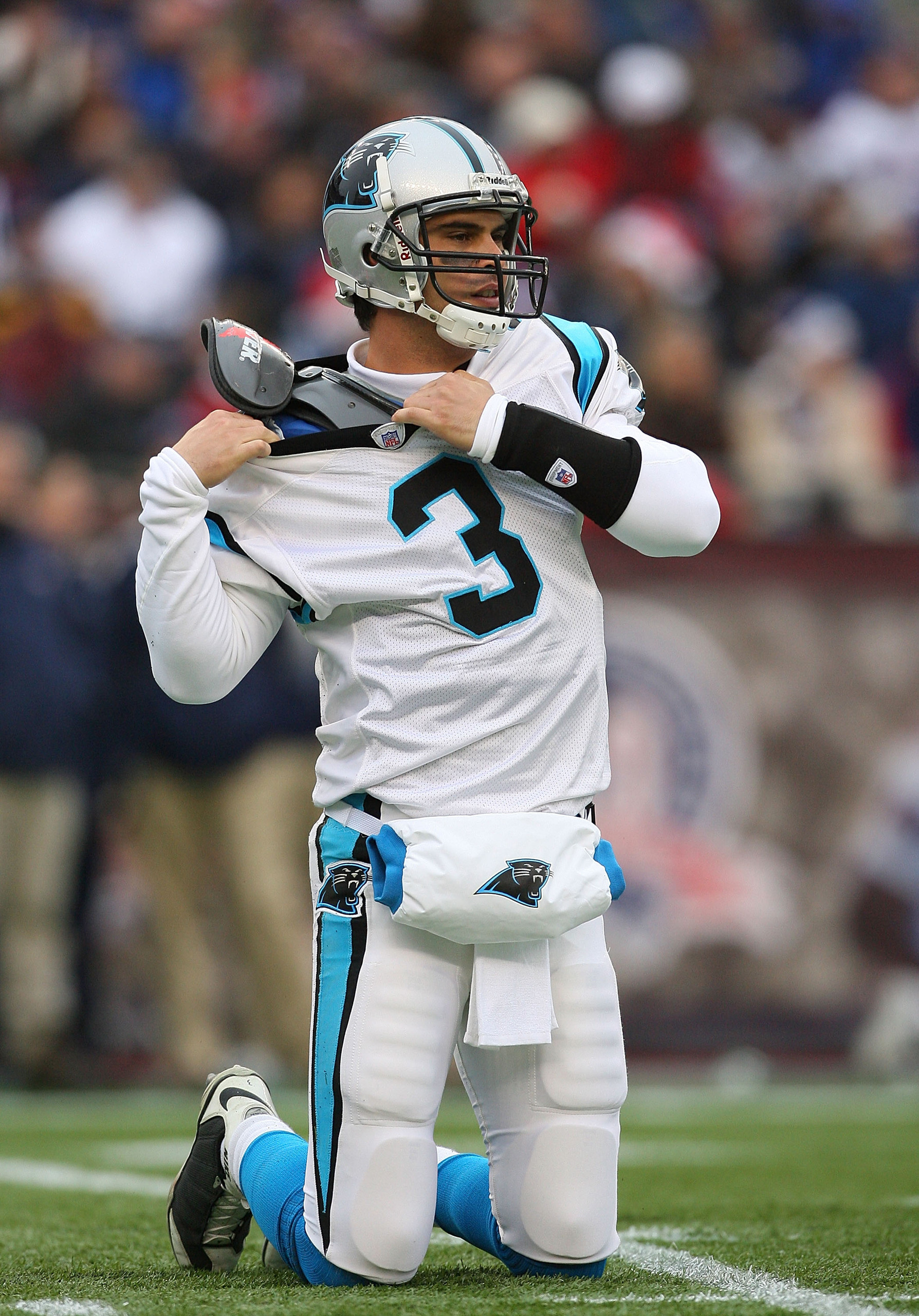 Carolina Panthers v New England Patriots 2009This image shows Matt Moore of the Carolina Panthers in 2009, highlighting the design and protective features of modern football uniforms.
Carolina Panthers v New England Patriots 2009This image shows Matt Moore of the Carolina Panthers in 2009, highlighting the design and protective features of modern football uniforms.
14. What Materials Are Commonly Used in Modern Football Uniforms?
Modern football uniforms utilize a variety of advanced materials that offer superior performance, durability, and protection. These materials include synthetic fabrics, high-strength plastics, and energy-absorbing foams.
Common materials include:
| Material | Properties | Use |
|---|---|---|
| Polyester | Lightweight, durable, moisture-wicking | Jerseys, pants |
| Nylon | High-strength, abrasion-resistant | Pants, protective gear |
| Spandex | Stretchable, comfortable, enhances mobility | Jerseys, pants |
| Polycarbonate | High-impact resistance, lightweight | Helmets |
| EVA Foam | Energy-absorbing, lightweight | Padding |
| Kevlar | High-strength, cut-resistant | Reinforcements in protective gear |
| Carbon Fiber | Lightweight, high-strength | High-end protective gear |
| Moisture-Wicking Fabrics | Draws sweat away from the skin, keeping players dry and comfortable | Jerseys, underlayers |
These materials are carefully selected to optimize player performance and safety. According to DuPont, advanced materials play a crucial role in modern sports apparel. At onlineuniforms.net, we source our materials from trusted suppliers to ensure the highest quality and performance.
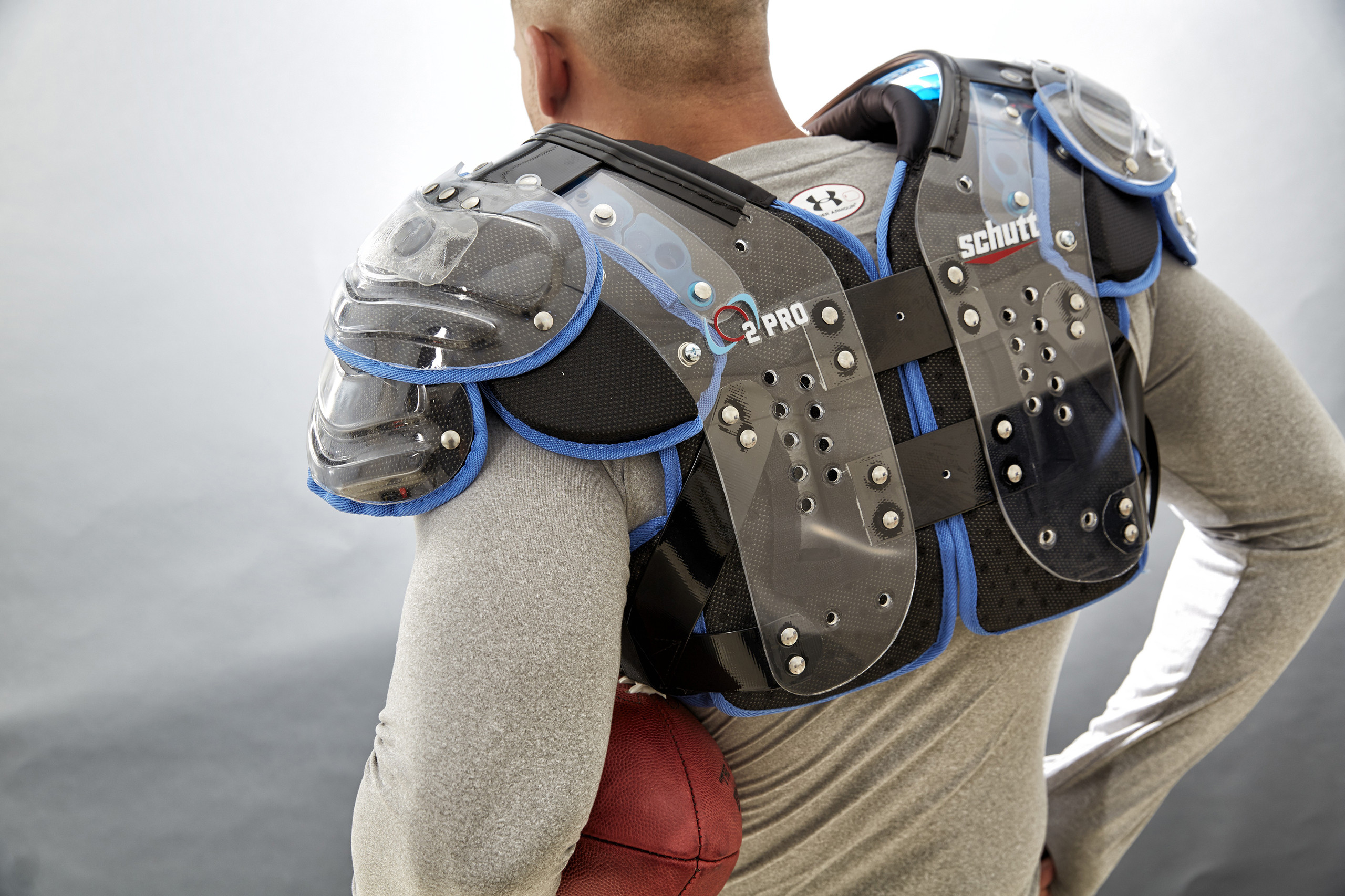 Radio-Frequency Identification by Zebra Technologies 2015This image shows a close-up view of the RFID player-tracking technology chip on shoulder pads from Zebra Technologies in 2015, highlighting the technological advancements in modern football uniforms.
Radio-Frequency Identification by Zebra Technologies 2015This image shows a close-up view of the RFID player-tracking technology chip on shoulder pads from Zebra Technologies in 2015, highlighting the technological advancements in modern football uniforms.
15. How Can Teams Ensure the Longevity of Their Football Uniforms?
Teams can ensure the longevity of their football uniforms by following proper care and maintenance procedures. These procedures include regular cleaning, proper storage, and timely repairs.
Key maintenance tips include:
- Regular Cleaning: Wash uniforms after each use to remove sweat, dirt, and stains. Follow the manufacturer’s instructions for washing and drying.
- Proper Storage: Store uniforms in a cool, dry place away from direct sunlight to prevent fading and damage.
- Timely Repairs: Repair any tears, rips, or damage to the uniform as soon as possible to prevent further wear and tear.
- Equipment Inspections: Regularly inspect helmets, shoulder pads, and other protective gear for signs of damage or wear. Replace any equipment that is no longer in good condition.
- Avoid Harsh Chemicals: Avoid using harsh chemicals or bleach when cleaning uniforms, as these can damage the fabric and reduce its lifespan.
Following these maintenance tips will help teams get the most out of their investment. According to the Sports Equipment Management Association (SEMA), proper maintenance can significantly extend the lifespan of sports uniforms.
16. Where Can Teams Purchase High-Quality Football Uniforms?
Teams can purchase high-quality football uniforms from reputable suppliers such as onlineuniforms.net. These suppliers offer a wide range of uniform options, customization services, and expert advice to help teams find the perfect fit.
When choosing a supplier, consider the following factors:
- Product Quality: Look for suppliers that offer uniforms made from high-quality materials that meet industry safety standards.
- Customization Options: Choose a supplier that offers a wide range of customization options, including logo design, embroidery, and printing.
- Customer Service: Select a supplier that provides excellent customer service and support.
- Pricing: Compare prices from different suppliers to find the best value for your money.
- Reputation: Read reviews and testimonials from other teams to get an idea of the supplier’s reputation.
onlineuniforms.net is a trusted provider of high-quality football uniforms and offers a wide range of customization options to meet your team’s needs.
17. What Are the Benefits of Investing in High-Quality Football Uniforms?
Investing in high-quality football uniforms offers numerous benefits, including enhanced player safety, improved performance, and a professional team image. High-quality uniforms are made from durable materials that provide superior protection, comfort, and performance.
Key benefits include:
- Enhanced Player Safety: High-quality uniforms provide superior protection against impact injuries, reducing the risk of concussion and other serious injuries.
- Improved Performance: Lightweight, breathable fabrics and ergonomic designs enhance player comfort and mobility, allowing them to perform at their best.
- Professional Team Image: High-quality uniforms create a professional and cohesive team image that can boost morale and attract sponsors.
- Durability: High-quality uniforms are made from durable materials that can withstand the rigors of the game, providing a longer lifespan and reducing the need for frequent replacements.
- Comfort: High-quality uniforms are designed for comfort, with features like moisture-wicking fabrics and ergonomic designs that keep players cool and dry.
These benefits make investing in high-quality football uniforms a worthwhile investment. According to a report by the National Federation of State High School Associations (NFHS), proper equipment is essential for player safety and performance.
18. How Do Football Uniforms Differ Between Professional and Amateur Levels?
Football uniforms differ significantly between professional and amateur levels due to variations in budget, technology, and performance requirements. Professional teams typically have access to the latest advancements in uniform technology, while amateur teams may rely on more basic equipment.
Key differences include:
| Feature | Professional Level | Amateur Level |
|---|---|---|
| Technology | Advanced impact sensors, GPS tracking, smart fabrics | Basic padding, standard helmets |
| Materials | High-performance synthetic fabrics, lightweight composites | Standard synthetic fabrics, basic plastics |
| Customization | Extensive customization options, unique designs, personalized features | Limited customization options, standard designs |
| Budget | Higher budget for uniforms and equipment | Lower budget for uniforms and equipment |
| Safety Standards | Strict adherence to safety standards, regular inspections, advanced protective gear | Adherence to safety standards, basic protective gear |
| Performance Needs | Optimized for peak performance, maximum comfort, and enhanced mobility | Designed for basic performance, adequate comfort, and sufficient mobility |
These differences reflect the varying demands and resources at each level of the sport. According to a study by the American College of Sports Medicine (ACSM), professional athletes require specialized equipment to meet the demands of their sport.
19. What Are the Key Components of a Modern Football Uniform?
A modern football uniform consists of several key components, each designed to provide protection, comfort, and performance. These components include the helmet, shoulder pads, jersey, pants, and accessories.
Key components include:
- Helmet: Provides crucial head protection, with advanced padding and impact sensors.
- Shoulder Pads: Protect the shoulders, chest, and upper back from impact injuries.
- Jersey: Made from lightweight, breathable fabrics, with team logos and player numbers.
- Pants: Feature integrated padding to protect the hips, thighs, and knees.
- Accessories: Include gloves, cleats, socks, and other items that enhance performance and comfort.
Each component plays a vital role in ensuring player safety and performance. According to the National Athletic Trainers’ Association (NATA), proper equipment is essential for preventing injuries in sports.
20. How Do Football Uniform Regulations Vary Across Different Leagues?
Football uniform regulations vary across different leagues, reflecting differences in safety concerns, branding guidelines, and aesthetic preferences. These regulations govern aspects such as uniform colors, logo placement, and equipment standards.
Key variations include:
- NFL: Strict regulations on uniform colors, logo placement, and equipment standards, with a focus on player safety and brand consistency.
- NCAA: Regulations vary by conference, but generally focus on player safety and fair play.
- High School: Regulations vary by state, with a focus on player safety and affordability.
- Youth Leagues: Regulations are typically less stringent, with a focus on affordability and accessibility.
These variations reflect the diverse needs and priorities of different leagues. According to the National Federation of State High School Associations (NFHS), uniform regulations are designed to promote fair play and protect player safety.
Navigating the evolution of football uniforms can be complex, but onlineuniforms.net is here to help. Whether you need cutting-edge designs, advanced materials, or reliable safety features, we’ve got you covered.
Ready to upgrade your team’s look and performance?
Visit onlineuniforms.net today to explore our wide selection of football uniforms, request a custom quote, and contact our expert team for personalized assistance. Elevate your game with uniforms that make a difference.
Address: 1515 Commerce St, Dallas, TX 75201, United States
Phone: +1 (214) 651-8600
Website: onlineuniforms.net
FAQ: Football Uniforms Over The Years
1. What Was the Primary Material Used in Early Football Uniforms?
Wool and canvas were the primary materials used in early football uniforms, providing basic durability and minimal protection.
2. When Did Plastic Helmets Become Standard in Football?
Plastic helmets became standard in football during the mid-20th century, specifically in the 1940s, offering superior head protection compared to leather helmets.
3. How Have Shoulder Pads Changed Over the Years?
Shoulder pads have evolved from simple felt and leather padding to sophisticated systems using high-impact plastics and energy-absorbing foams for better protection.
4. What Are Some Key Technologies Used in Modern Football Uniforms?
Key technologies include impact sensors, GPS tracking, moisture-wicking fabrics, and advanced materials like Kevlar and carbon fiber.
5. Why Is Customization Important in Football Uniforms?
Customization is vital for team branding, creating a unique identity, and fostering team unity, as well as enhancing fan engagement and merchandise sales.
6. What Safety Standards Must Football Uniforms Adhere To?
Football uniforms must adhere to safety standards set by organizations like NOCSAE and ASTM International, ensuring helmets and padding meet minimum performance criteria.
7. How Do Modern Football Uniforms Enhance Player Performance?
Modern uniforms enhance performance by using lightweight, breathable fabrics, ergonomic designs, and moisture-wicking technologies to keep players comfortable and agile.
8. What Are Some Memorable Football Uniform Designs in History?
Iconic designs include Notre Dame’s gold helmets, the Dallas Cowboys’ star logo, and the Oakland Raiders’ silver and black color scheme.
9. What Trends Are Shaping the Future of Football Uniforms?
Trends include smart uniforms with wearable technology, sustainable materials, enhanced protective gear, and highly customizable designs.
10. Where Can Teams Purchase High-Quality and Customizable Football Uniforms?
Teams can purchase high-quality and customizable football uniforms at onlineuniforms.net, which offers a wide range of options to meet diverse team needs and preferences.
